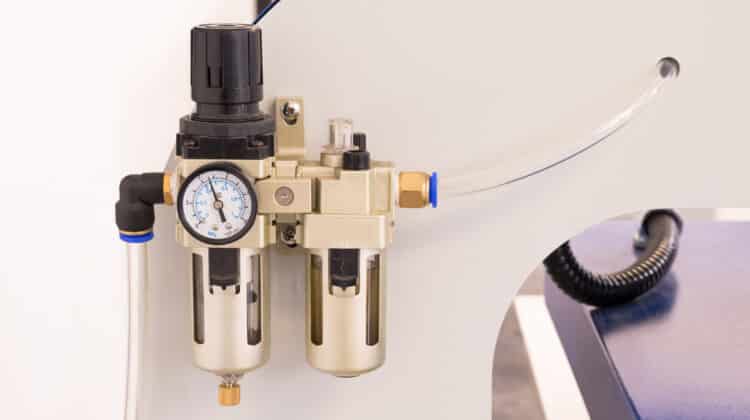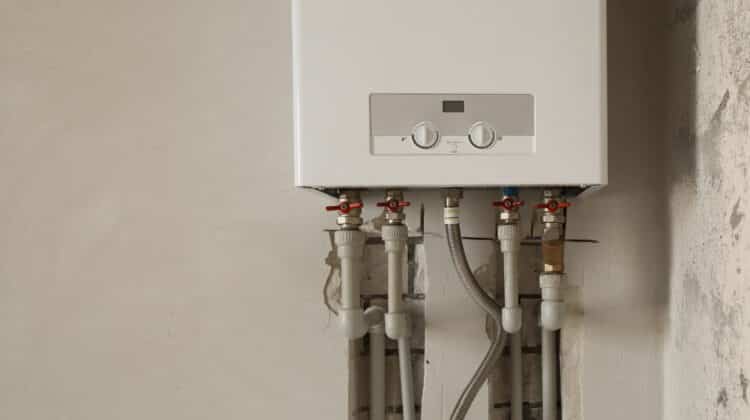
The purpose of the water heater gas control valve is very simple. As its name says, it controls the gas flow into your water heater. After that, a series of things happen to heat your water supply in the water heater tank. It stands to reason that if the water heater control valve is faulty, you will be left out in the cold.
But that’s not the only problem your water heater will suffer if the gas control valve does not work well.
Read on to learn everything you need to know about your water heater gas control valve.
Table of Contents
How Does The Water Heater Control Gas Valve Work?
I mentioned before that the gas valve controls the gas flow into your gas water heater. But that is not its only job. The smart design of these devices allows them to serve a much more complex function than that.
Here’s what happens inside your water heater that it can deliver hot water whenever you need it to.
A gas line connects with the water heater gas control valve. It regulates the gas flow to your unit. When you use the water heater, the gas control valve will cause the ignition of the pilot flame. The ignited pilot then heats up the thermocouple.
When the thermocouple is hot enough, it delivers tiny electrical pulses back to the gas control valve.
Those pulses are a signal that opens up the safety shut-off valve and allows the gas flow to continue to reach the pilot light.
The pilot light will flame brighter and hotter when the gas reaches it. It will heat up the burners that will then make your water hot.
So, without a gas control valve that works well, you will not have any hot water.
But wait, there’s more.
The gas control valve has two probes sticking out of it. These probes are the heat limiter probe and the temperature probe.
What Does The Temperature Probe Do?
The long probe is a temperature probe as well, but it functions differently. It works by responding when the water in the tank gets too hot or too cold.
When the water gets hot then cools, a rod within the long probe presses a lever inside the gas valve. It cuts the gas off when the water gets to the temperature you set. Then it turns the gas back on if the water goes below that temperature.
This Is What The Heat Limit Probe Does
The short probe is a heat limiter that acts as a sort of safety device. It senses if the water in the tank gets too hot. It works with the thermostat and thermocouple as a sensory team. Together the manage the temperature of the water in your tank.
Automatic Shut-off Feature
If the water in your water heater reaches a critical temperature, the gas valve shuts down.
The temperature in your water heater must not reach a critical level. If that happens, it can lead to serious damage to your water heater and the rest of your property. It can also cause grave injuries to users.
The shut-off feature engages if the temperature probe fails to do its job and your water gets too hot.
Troubleshoot The Gas Control Valve
There are many parts involved with the operation of the gas control valve.
- Thermostat
- Thermocouple
- Pilot
- Heat limiter
- Gas valve
- Temperature probe
The gas control valve on your water heater controls these features.
- The pilot
- The water temperature
- The automatic shut down feature
But, any one of these parts could be the cause of your water heater not heating up struggles.
The heating problems your water heater has may not be with the gas control valve. Try not to assume that it is because it is not often that hear of gas control valves failing. And they are pricey pieces of equipment. More than likely, you will find that the thermocouple is the problem.
So, before you chuck your gas control valve, ensure that it is the cause of your water heater troubles.
The only way to determine the cause of the problem is by troubleshooting. Here is how you find out which part is the guilty party.
Troubleshoot The Thermocouple
Your water heater must remain on to perform the troubleshooting test.
- Read the instructions on your water heater. It will tell you how to light the pilot.
- Push down on the pilot button, then release it.
If the flame goes out when you release the button, the thermocouple is the likely suspect. You will need to replace it.
Thermocouples are cheap devices. You can save even more money by replacing them yourself. The process is easy, but we won’t go into it here.
When you put in the new thermocouple, ensure you did it the correct way.
- Ensure the end of the probe touches the pilot flame.
- Ensure that you screw the thermocouple in tight by the control valve.
- Ensure that the line for the thermocouple is not kinked
If the thermocouple was the cause of the problem, this should fix everything. But if the pilot still won’t stay on after putting in the new one, you have bigger problems. The gas control valve is the problem.
Check the gas supply if the pilot will not ignite at all with the pilot button pressed.
If the pilot does not ignite despite having gas, the orifice may have a blockage. It could also be a clogged pilot.
Troubleshoot The Heat Limiter And Thermostat
You can choose to replace only the heat limiter or thermostat if they are the parts causing problems. But, it might be a better idea to replace the gas control valve. Doing so is only slightly more expensive.
Anytime a heat limiter trips, you have to change it. But replacing the heat limiter alone may not be enough to solve the problem. You can replace it. But a failed heat limiter is almost always a sign that the thermostat and gas control valve has failed as well.
The thermostat in water heaters can fail. Is the water coming from your water heater is scalding hot? Do you hear the burner running? Try lowering the thermostat. Turn it down all the way.
The burner should shut off. If it stays on, you need to shut off the supply of gas to the water heater and put in a new gas valve.
Consider this scenario.
The pilot works. The thermostat is up. But you have a tank of cold water and the burner is not firing.
You may have a clogged burner orifice. Or the gas valve has a problem.
Take out the burner assembly. The orifice is under the burner, at the end of the burner supply line. Also, inspect the burner supply tube.
It is the only way you will know if these parts are responsible for your water heater troubles.
What Does A Gas Control Valve Cost?
I said before that a gas control valve is a pricey piece of equipment. How expensive it is will vary based on the manufacturer. But you can expect to pay upwards of $100 for a new one. That price doesn’t include the cost of labor if you hire a professional.
It Is Time To Replace Your Faulty Gas Control Valve
Working with natural gas can be quite dangerous. So always turn it off before attempting to repair your gas-powered water heater. Contact a qualified contractor if you are not comfortable working in this atmosphere.
If you smell gas after shutting off the gas, abandon the project. Leave the area and call a professional.
If your water heater gas control valve has a problem, there are no repairs you can make to fix it. The only option is putting in a new one. For most gas water heaters, the process of replacing the gas control valve is simple.
It is a good idea to start by reading the manual that came with your water heater.
Water heaters are different based on make and models. So, there may be maintenance rules that apply to all, there may be slight deviations in the process.
The next thing you need to do is take off the old valve.
Bring the valve to a hardware store once you take it off. There, you can find an exact replacement.
I’ve never liked the idea of aftermarket parts simply because they do not last as long as genuine parts. But they are cheaper. If that is what your budget can afford, then go for it.
These are the steps to follow to replace the gas valve.
- Turn the water heater off
- Shut off the gas
Use an adjustable wrench to disconnect the lines connecting with the gas control valve. It is critical to keep the water heater steady when you apply torque to those connectors. Otherwise, you risk causing more damage. - Put in the new valve.
All you have to do is to put in the new valve. Reverse the steps you used to take out the old.
If there is no smell of gas in the air or the scent of rotten eggs, it is safe to turn the gas and water heater back on.
Newer model gas-powered water heaters may have wires connecting with the control valve. These wires then connect with a thermal fuse inside the burner compartment. The thermal fuse turns the gas coming into the water heater off if there is any flash fire. If you have one of those models, it is necessary that you reinstall them when you replace the gas valve.
Final Thoughts On Water Heater Gas Control Valve Replacement
Putting a new gas control valve on your water heater is a simple four-step process. Although the gas control valve is expensive, you can save on the cost of labor by doing it yourself.
But if you are not comfortable with the idea of working with gas, that is understandable. It can be dangerous, especially if you are not careful. Call a professional. You can expect to pay anywhere from $200 to $750.





